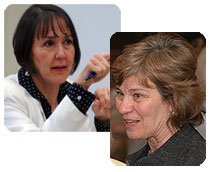Teaching and Learning in Tandem
When it comes to first-year college classes, two professors are sometimes better than one.
 That’s the philosophy behind “tandem” courses at Saint Mary’s, which let first-year students explore two academic fields at once, with a two-professor team, as they fulfill their general education requirements.
That’s the philosophy behind “tandem” courses at Saint Mary’s, which let first-year students explore two academic fields at once, with a two-professor team, as they fulfill their general education requirements.
Professors Gail Mandell and Becky Stoddart recently paired up to offer a tandem course called “Book Club: Culture and the Self.” With Mandell, a professor of Humanistic Studies, students read a wide range of personal accounts that highlighted “enduring human concerns,” especially the role of culture and society in shaping identity. With Stoddart, a professor of psychology, they were introduced to major theories and methods of studying human behavior.
Tandems help students compare and integrate ideas and approaches from different disciplines—for example, psychology and English, or religious studies and philosophy. Since the classes are small (15 to 20 students), discussions spark intellectual exchange and build confidence.
“For me, the main advantage is that it forms a tightly-knit learning community early in the student’s college career,” says Mandell, who has taught tandems for many years. “They learn so much and are growing so much in these courses.”
Tandem participants meet four times a week for seminar-style discussion, and hone their writing and analytical skills in a weekly writing lab. “We all spend so much time together that we really develop a sense of trust in each other,” says Tavierney Rogan, a first-year student.
Rogan took a year off between high school and college, but says the “Book Club” tandem “whipped her back into shape” academically. “We read Interpreter of Maladies by Jhumpa Lahiri, a collection of short stories about people from India and their experiences with acculturation. We then studied acculturative stress alongside it in psychology. The short stories were magnificent and the topic of acculturation was really interesting because it is so pervasive in modern times.”
For Stoddart, tandems are demanding but worthwhile because they build bridges—between disciplines, students, and professors. “By accepting each other’s fields, I think Gail and I create a classroom that accepts everybody. Students see connections that we don’t see, and we’re more likely to hear them, I think, in a tandem structure.”

